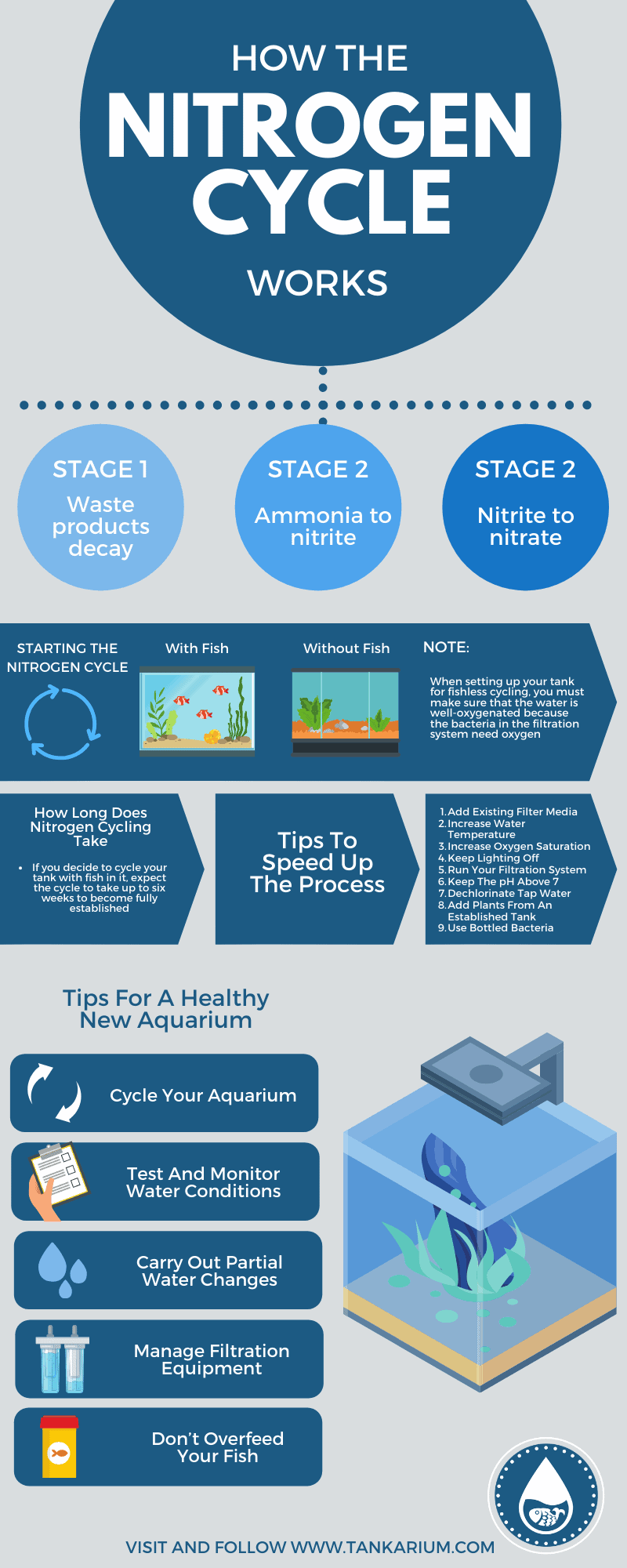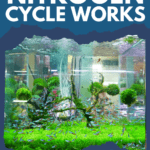Unlike the natural habitats of most tropical fish species, where dangerous levels of nitrogen-containing compounds are rare, the freshwater home aquarium is a closed environment in which overcrowding and overfeeding are common. That makes your fish tank conducive to excess ammonia and nitrification in the water, which is the most common cause of sickness, disease, and even death in aquarium fishes.
In this guide, we explain how the nitrogen cycle in the aquarium works, as well as giving you lots of helpful tips on how to keep your tank water pristine and safe for your fish.
What Is The Nitrogen Cycle?
In nature, the nitrogen cycle describes the process where nitrogen moves from the air to plants, to animals to bacteria, and then back to air. That system works just fine and needs no human intervention. However, the cycle works differently in the enclosed environment of the aquarium.
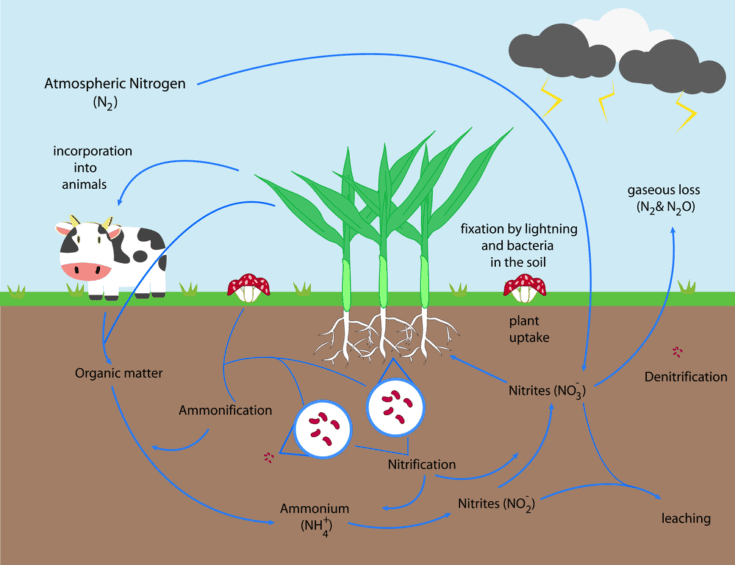
In a fish tank, the process is a biochemical mechanism that sees the continual degradation of various nitrogenous compounds from ammonia to nitrite to nitrate. In the last phase of the cycle, nitrates are taken up by living plants in the tank and used as nutrients or removed from the water via partial water changes and your biological filtration system.
Biological Filtration System
In the aquarium, it’s up to the hobbyist to manage the nitrogen cycle effectively by using a biological filtration system. The biological filtration system contains sponges that act as a platform for the growth of beneficial bacteria. Those bacteria are vital to the nitrogen cycle process, as they work to break down the ammonia and nitrites produced by fish waste and decaying organic matter, keeping the water safe for your livestock.
A colony of bacteria in the filter system takes up to three months to become sufficiently established to be able to convert ammonia and nitrites to nitrate. For that reason, it’s advisable to take time in stocking a new aquarium with a few small fish at a time to allow the biological filter to keep pace with the gradually increased bioload in the tank.
Stages Of The Nitrogen Cycle
The nitrogen cycle is the process by which certain bacteria process harmful waste. There are three stages to the cycle:
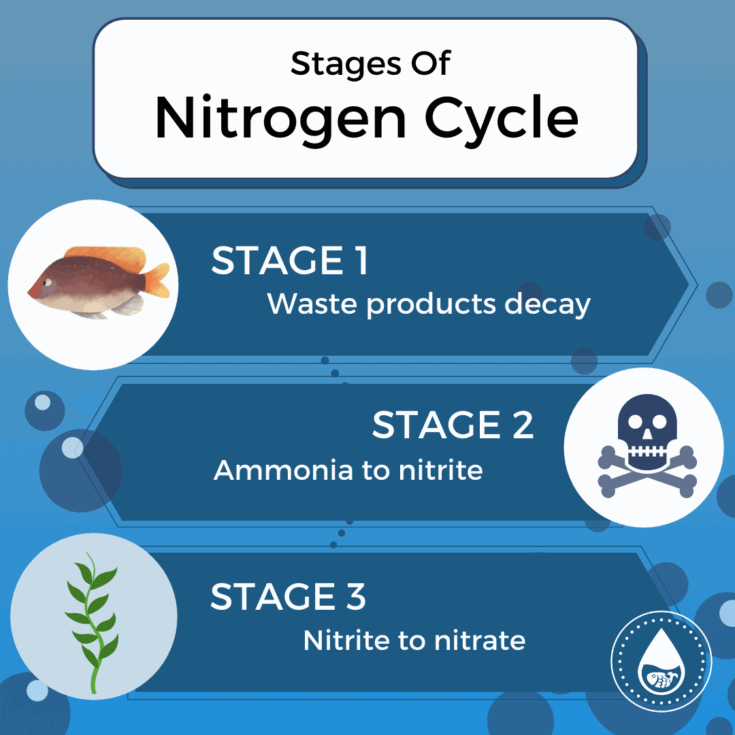
1. Waste Products Decay
The first stage in the nitrogen cycle is the decay of organic matter, such as uneaten food, dead plant leaves, dead organisms, and the waste produced by fish and invertebrates. As bacteria cause these materials to break down, the metabolism of protein produces ammonia.
Ammonia is a colorless gas that is extremely toxic to fish, and even low levels in the water will cause oxygen deprivation and even burn the fishes’ delicate gills. High ammonia levels in aquarium water usually occur because there are too many fish in the tank or the fish are overfed.
2. Ammonia To Nitrite
In a balanced aquarium, nitrogen-fixing bacteria called Nitrosomonas consumes the ammonia, oxidizing it to create nitrite. Nitrite is also toxic, disrupting the oxygen-carrying capabilities of blood, but fish can generally cope with twice the quantity of nitrite in the water when compared to ammonia.
3. Nitrite To Nitrate
In the third stage of the nitrogen cycle, bacteria called Nitrobacter process the nitrites, releasing a less toxic chemical called nitrate. Although nitrates are not toxic at low levels, if the concentration rises above 20 ppm, they can become dangerous to fish. In nature, nitrate converts aerobically into harmless nitrogen gas. That doesn’t happen in the closed environment scenario of most aquariums, meaning that partial water changes are necessary to dilute the nitrate.
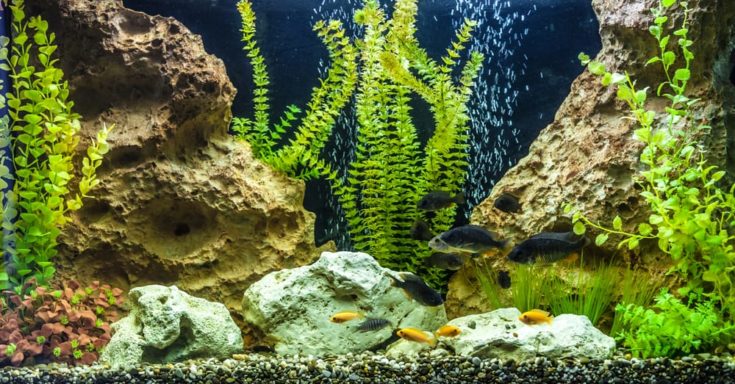
Live plants help to remove nitrates from the water in freshwater tanks. In a saltwater setup, live rock and deep sand beds can provide anaerobic areas where denitrifying bacteria process nitrates into nitrogen gas, which then evaporates harmlessly.
This aquarium nitrogen cycle diagram illustrates the process perfectly.
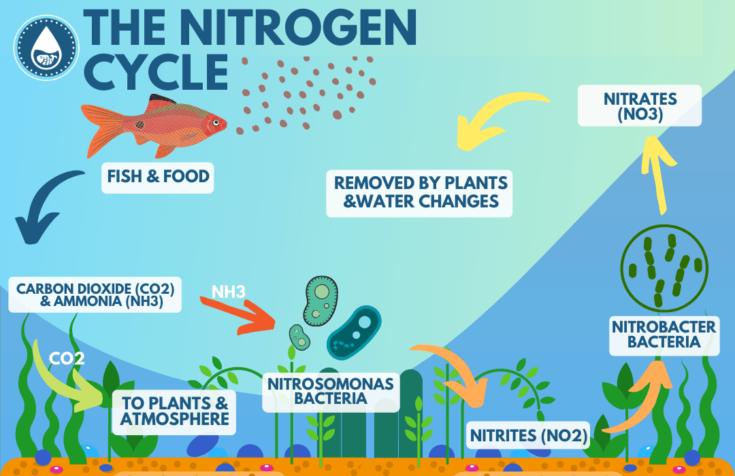
Starting The Nitrogen Cycle
So, you can see that the key to clean, healthy water that’s free-from toxins and is safe for your fish is to get the nitrogen cycle established and working efficiently. The process of establishing and maturing your biological filtration system is referred to in the hobby as “cycling.”
In a new fish tank, you can cycle the aquarium with or without fish.
Starting The Nitrogen Cycle With Fish
When you add fish to your new aquarium, they begin to produce waste and ammonia, and decaying fish food will also be added to the mix. Unfortunately, these fish often don’t survive, earning them the nickname “suicide fish.”
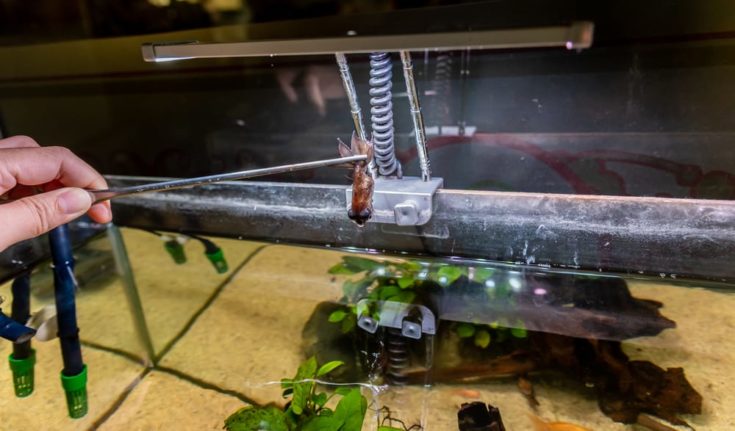
As a new filtration system does not contain any established Nitrosomonas bacteria colonies to consume the ammonia that the fish produce, levels of the toxin rise and ultimately spike until the bacteria population catches up.
You can see that phenomenon taking place quite easily as the water in the aquarium becomes temporarily cloudy. Once the bacteria take control of the situation by breaking down the ammonia, the water will clear, and the ammonia level drops.
Nitrite Spike
As the Nitrosomonas bacteria consume the ammonia in the tank, nitrite is produced. As the number of bacteria increases, so does the level of nitrite. In response, the population of nitrite-eating Nitrobacter bacteria skyrockets due to the number of nutrients that are available to them.
Once that nitrite spike is reached, the levels of nitrite in the water will decrease, as the bacteria break down the chemical faster than it is being produced.
Nitrate Management
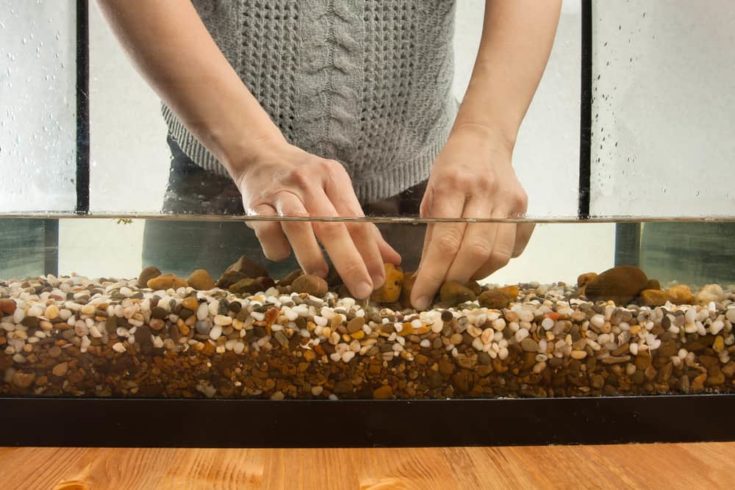
The final end product of the nitrogen cycle is nitrate. While in low concentrations in the water, nitrate is not as dangerous to fish as ammonia or nitrites, although it can cause other problems in the tank, such as algae blooms.
To control the levels of nitrates in the water, you need to carry out partial water changes every week. The addition of live plants is also extremely effective in controlling nitrates as the plants extract the chemical from the substrate and from the water column to use as a nutrient-rich fertilizer.
When Is The Aquarium “Cycled”?
The usual method of cycling a new tank is to introduce a few hardy fish to kick off the nitrogen cycle. The idea of using these starter fish is to introduce ammonia, fish waste, and food to the mix. Once your test kit no longer registers levels of ammonia and nitrite in the water, the cycle is complete.
How Long Does Cycling Take?
In a tank where fish are present, cycling the tank can take anywhere from 30 to 45 days. Once cycling is complete, you can add more fish to your community, as the bacteria colonies in the filter media are now able to cope with the additional bioload.
Starting The Nitrogen Cycle Without Fish
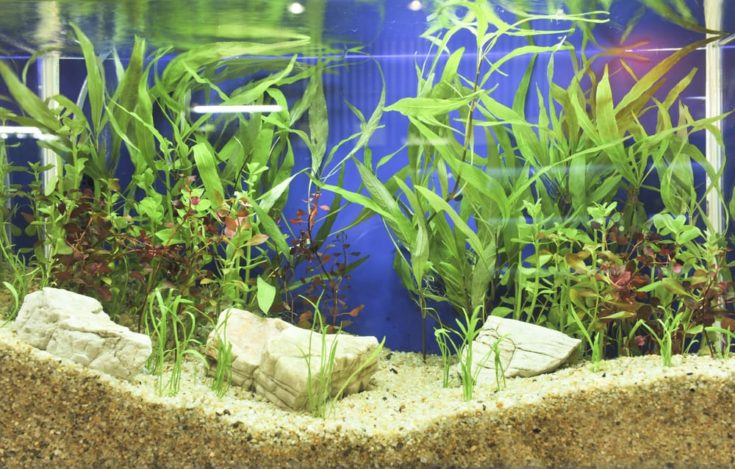
If you don’t want to risk the lives of your new fishes by putting them into an uncycled tank, you may prefer to cycle the tank without fish. There are two ways to do that.
Use Fish Food To Cycle The Tank
Start by setting up your new tank with everything that you need except fish, including:
- Filtration
- Heater
- Lighting
- Protein skimmer for marines and reef setups
- Plants
Set your heater to around 82° Fahrenheit, start the filter pump, and begin “feeding” the tank with fish flakes.
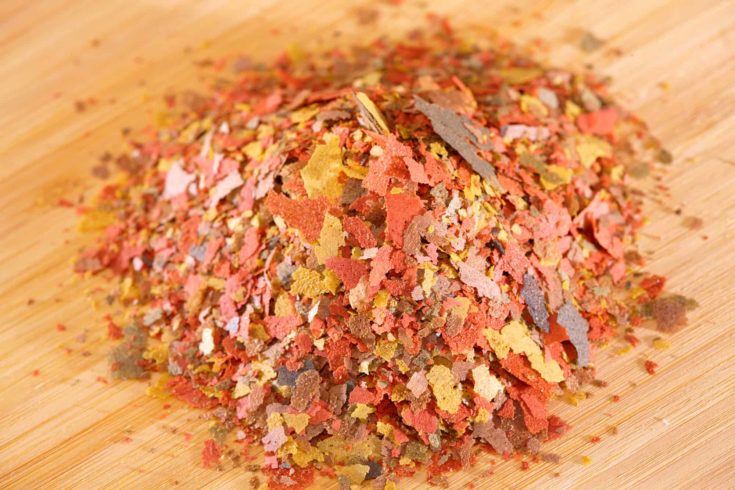
As the food decomposes, it releases ammonia, triggering the aquarium to begin the cycling process. You can speed up the process by seeding the tank with a small quantity of substrate, filter media, decorations, etc. from an established tank. These items introduce bacteria to the new aquarium, and the ammonia produced by the decaying fish food will provide plenty of nutrition for the new colonies to become established and to expand.
Essentially, the nitrogen cycle works in the same way as described above; ammonia is converted to nitrite, and nitrite then becomes nitrate.
Disadvantages To Fishless Cycling
The fishless method of cycling the tank does have a few downsides. Firstly, the ammonia that’s produced by the decomposing fish food may not create sufficient bacteria colonies to cope with the fish when you introduce them. So, there is still the danger that the arrival of the fish will trigger ammonia and nitrate spikes.
However, these new spikes are typically shorter and less intense than those that occur during the initial cycle. Therefore, the fish are much less likely to suffer any ill effects, and the survival rate is, consequently, higher.
Cycling A Tank By Using Ammonia
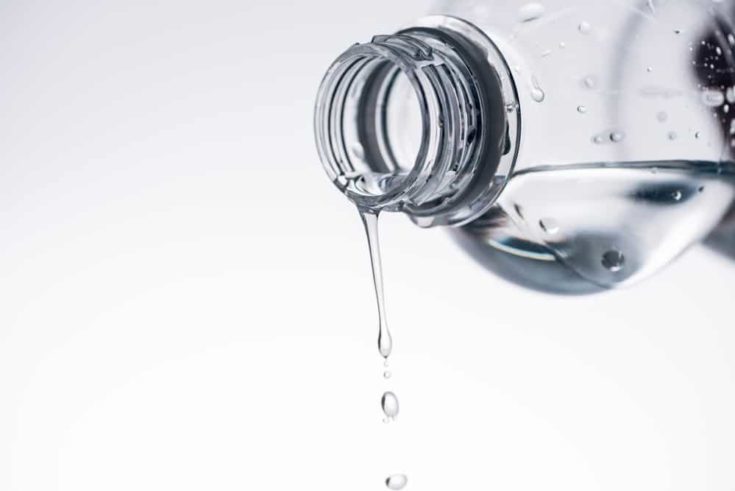
Whether you take the fish or fishless route to cycling your tank, both methods have one thing in common; ammonia.
Did you know that you can use pure ammonia for cycling your aquarium? Well, you can, and introducing pure ammonia to a fishless tank is a very effective method of starting the cycling process.
Simply add five drops of pure ammonia to every ten gallons of water every day. The levels of ammonia in the water will quickly rise from zero to 5 ppm and above. Keep testing the water each day, and once nitrites are measurable, decrease the ammonia to just three drops each day. Continue adding ammonia until the measurements of both ammonia and nitrites are zero ppm, meaning that the aquarium is then fully cycled.
Important Points To Note
When setting up your tank for fishless cycling, you must make sure that the water is well-oxygenated. That’s because the bacteria in the filtration system need oxygen, so it’s helpful to add plants to the setup and perhaps include an air stone too.
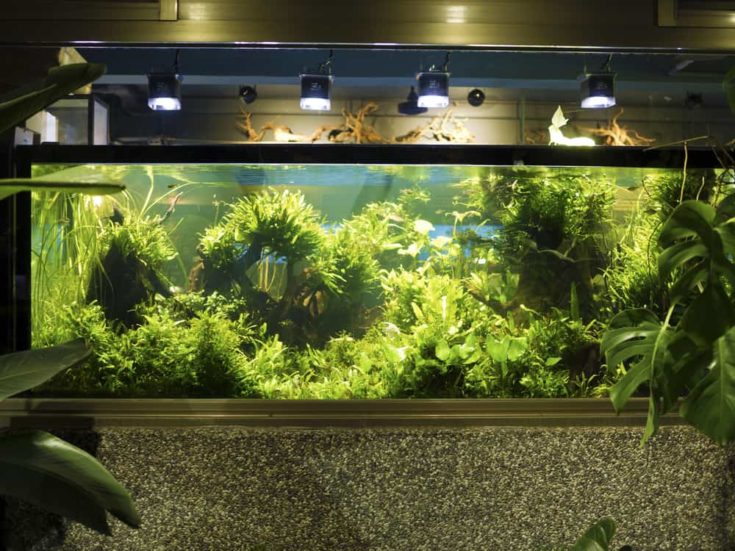
Make sure that the ammonia you use does not contain any additives or perfumes. Also, do not treat the tank water with any conditioning products that are known to remove ammonia. When the cycle is complete, place some activated carbon in the filtration system to get rid of any possible perfumes or additives that may have been hidden in the ammonia that you used.
Finally, once you introduce fish to the aquarium, they will produce sufficient waste to keep the cycle going and balance the environment within their habitat, and you can, therefore, discontinue seeding the tank with ammonia.
Test Kits
Before you begin cycling your aquarium, whichever method you decide to use, you’ll need to invest in several test kits that you will use to check the levels of ammonia, nitrite, and nitrate in the water.
Throughout the cycling process, you’ll need to test the water in your tank every day to give you an idea of where you’re at in the cycling process. Here are some handy links to test kits that we recommend:
- Ammonia test kit
- Nitrite test kit
- Nitrate test kit
- Saltwater test kit
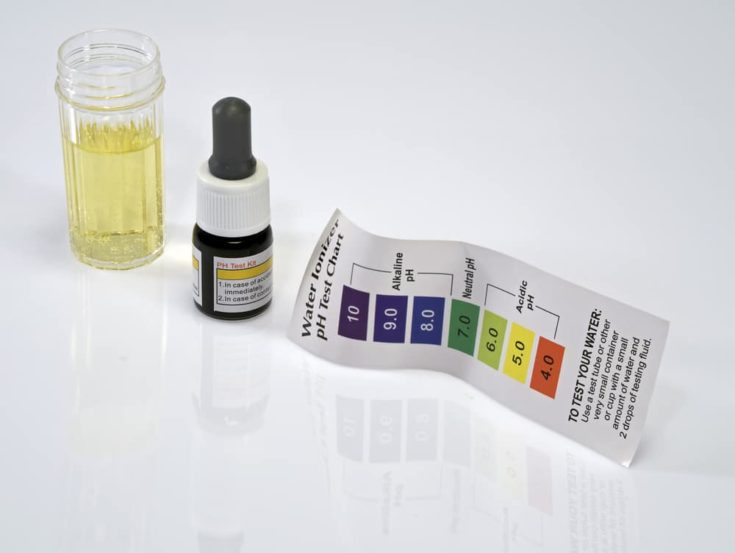
Be sure to read and follow the test kit manufacturer’s instructions carefully so that the results of your testing are accurate. Remember that you’re aiming for zero levels of ammonia and nitrites and a level of a maximum nitrate level of 20 ppm.
How Long Does Nitrogen Cycling Take
Generally, it takes between two and six weeks for a fish tank to be cycled, although that timespan varies, depending on several factors, including:
- the level of ammonia that’s present during the cycling period
- the efficiency of your biological filter system
- whether you have used living plants or live rocks in the process
- whether you have used any form of boosting additives or biomedia
If you decide to take the route of cycling your tank with fish in it, you can expect the cycle to take up to six weeks to become fully established and working efficiently.
One big advantage of using ammonia to cycle your aquarium is that the whole cycle can complete in just seven days, and the scenario is similar if you use the seeding method described above. Also, once the tank is cycled, the bacteria colonies present are large enough to cope with a fully stocked aquarium.
Tips To Speed Up The Process
Waiting for your aquarium to cycle before you can add fish is frustrating, but there are a few ways to speed up the process:
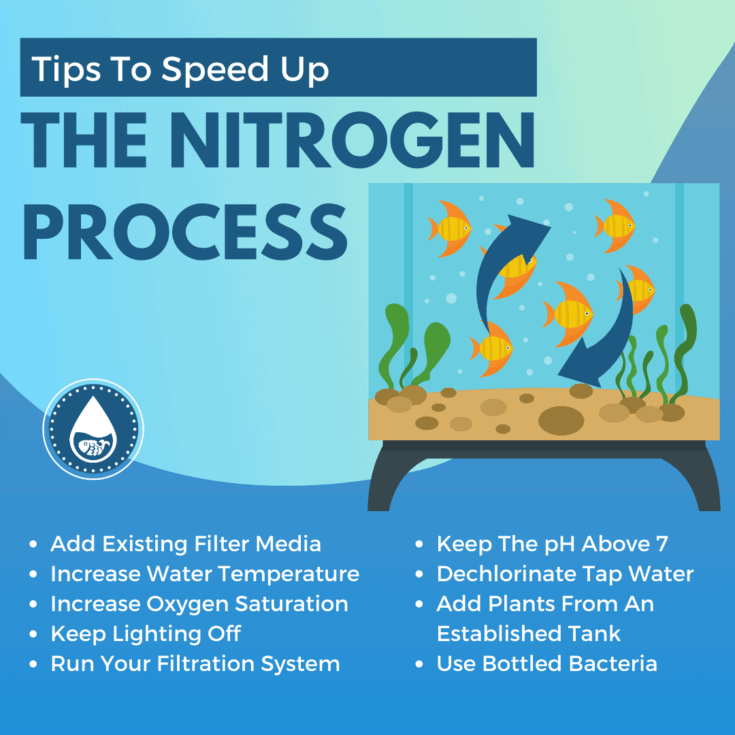
1. Add Existing Filter Media
Add filter media, substrate, or rocks from an already established aquarium. That’s the most effective way to speed up the nitrogen cycle in a new tank. Period.
Adding filter media from a cycled tank kick starts the population of bacteria in the new environment, helping to prevent ammonia and nitrite spikes, and cutting weeks off the usual nitrogen cycle timeline.
However, you must be sure that the established aquarium is healthy with no signs of disease or parasites before adding anything from it to your new tank.
2. Increase Water Temperature
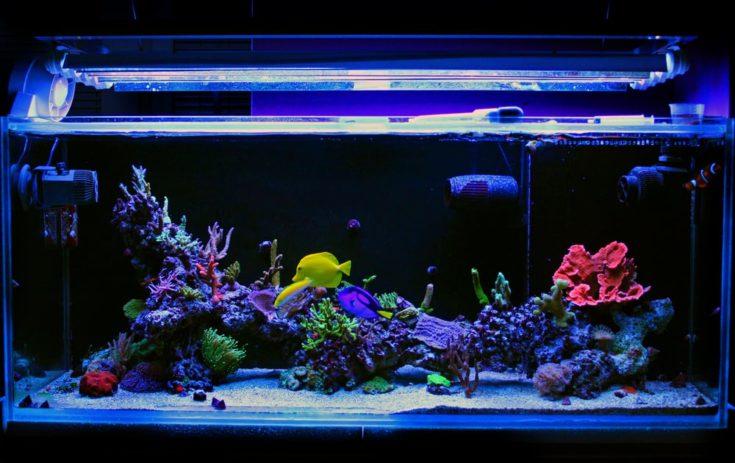
The bacteria in the nitrogen cycle reproduce more quickly in a warm environment, and increasing the water temperature helps to increase the population of bacteria quickly. From personal experience, the ideal sweet spot for maximum bacteria proliferation is between 82° and 87° Fahrenheit.
That temperature is fine when cycling an empty tank, but it is too high for many species of fish and could be harmful to them.
3. Increase Oxygen Saturation
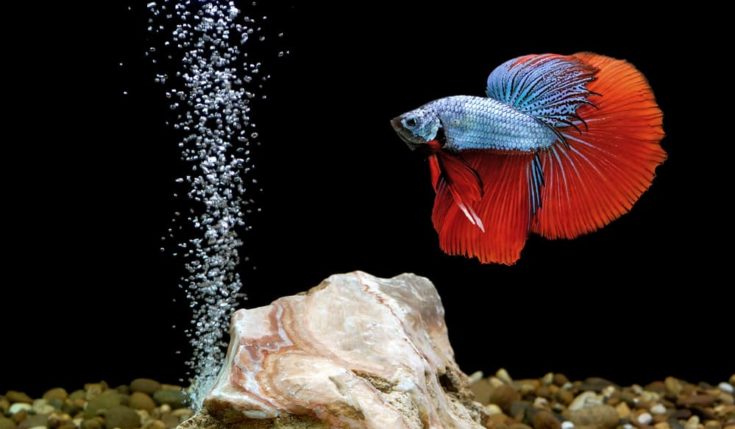
Just like fish, bacteria that consume ammonia and nitrite require well-oxygenated water to thrive. So, by increasing the oxygen saturation levels in the aquarium, you can really boost bacterial growth. Also, warm water is not efficient at retaining oxygen, so increasing levels by using an air stone is a good plan if you intend to increase the tank temperature as well.
4. Keep Lighting Off
Nitrifying bacteria grow most quickly in a darker environment. So, keep your tank lights off until the cycle is over. Also, don’t allow too much natural sunlight to illuminate the aquarium, as that inhibits the growth of bacteria, as well as causing algae to bloom.
5. Run Your Filtration System
Nitrifying bacteria grow best in an environment where there is constant water flow, no lighting, and a porous surface. So, allowing your filter system to run during the cycling process can considerably boost bacterial proliferation.
6. Keep The pH Above 7
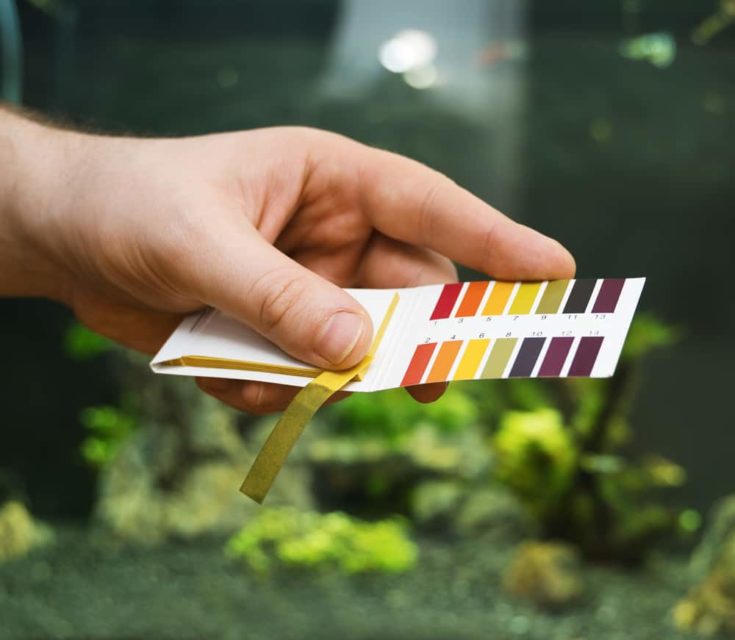
If the water pH level falls below 7, the growth of bacteria in the tank may slow or come to a complete stop. So, be sure to test the pH regularly, and increase the level if it drops below 7.
7. Dechlorinate Tap Water
Whenever you add tap water to the tank, always use a dechlorinator to remove chlorine and chloramines from the water. These chemicals are lethal to the bacteria that you are trying to grow in your tank, and they’re also toxic to your fish.
8. Add Plants From An Established Tank
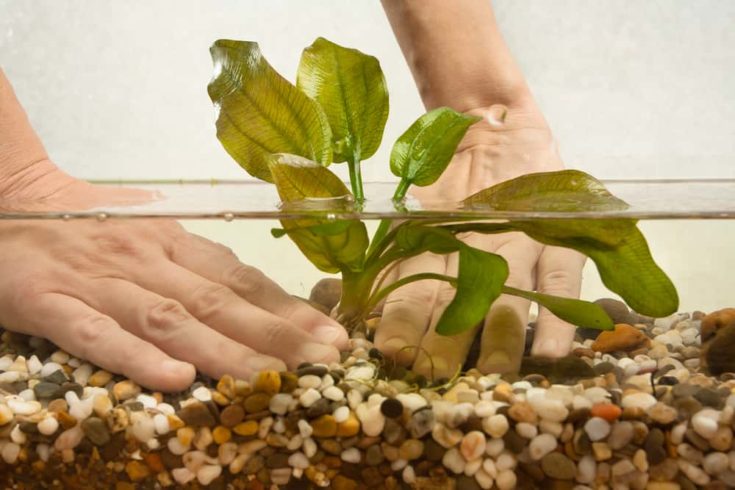
Ammonia consuming bacteria live on the surface of plant leaves, so adding a few plants from an already cycled tank is a great way to accelerate the nitrogen cycle. However, do remember to check the leaves carefully for snails before introducing them to your new setup.
9. Use Bottled Bacteria
Another way to speed up the aquarium cycling process is by adding concentrated, live nitrifying bacteria from a bottle. That sounds great in principle, but the results tend to vary, largely because not all these products contain the same species of bacteria.
Although all kinds of nitrifying bacteria are capable of consuming ammonia and nitrites, not all bottled bacteria products contain those specific types of bacteria that will grow in your filter media. One product that definitely does contain those essential bacteria is Tetra SafeStart.
When used according to the manufacturer’s directions, bacteria-in-a-bottle can increase the speed of your tank cycle significantly. However, you must store the bottle correctly, i.e., away from direct sunlight, excessive heat and cold, or the bacteria may die. Also, once the bottle is past the use-by date, the bacteria inside will most likely be dead or dying and are of no use to your aquarium cycling process.
Tips For A Healthy New Aquarium
It’s true to say that you never stop learning when you keep fish. But here are a few top tips for a healthy new aquarium to get you started the right way.
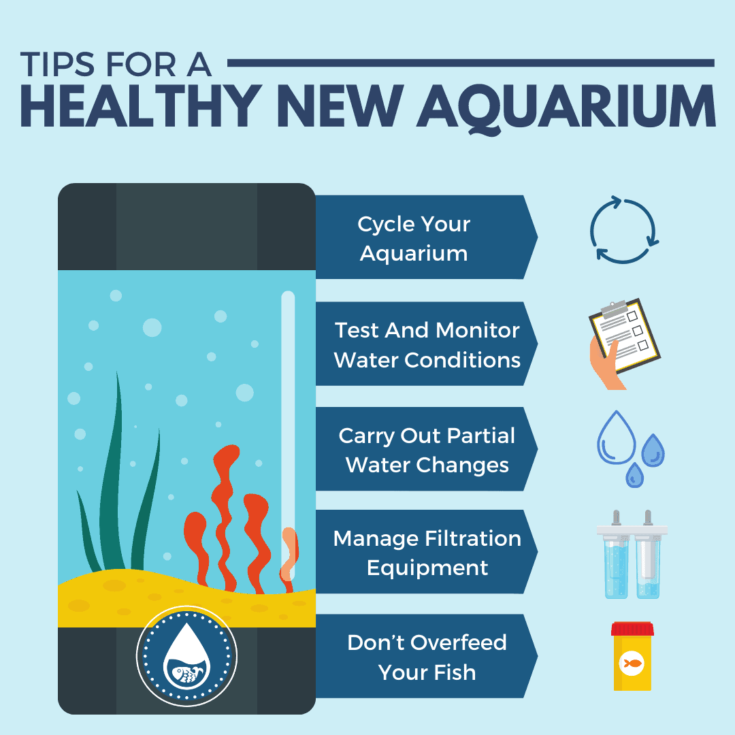
1. Cycle Your Aquarium
First, and most importantly, you must cycle your aquarium correctly, using one of the methods we’ve described above. A properly cycled tank will be safe for your fish and gets you off to the best start possible.
2. Test And Monitor Water Conditions
For your fish to remain healthy, the water in their tank must be clean and free from toxic chemicals.
I strongly recommend that you get into the habit of testing the water in your aquarium at least once a week to keep an eye on the levels of ammonia, nitrites, and nitrate in the tank. You also need to monitor the pH level of the water to ensure that it is suitable for your fish. If necessary, you may need to add a pH buffer chemical to the water to correct the water hardness.
3. Carry Out Partial Water Changes
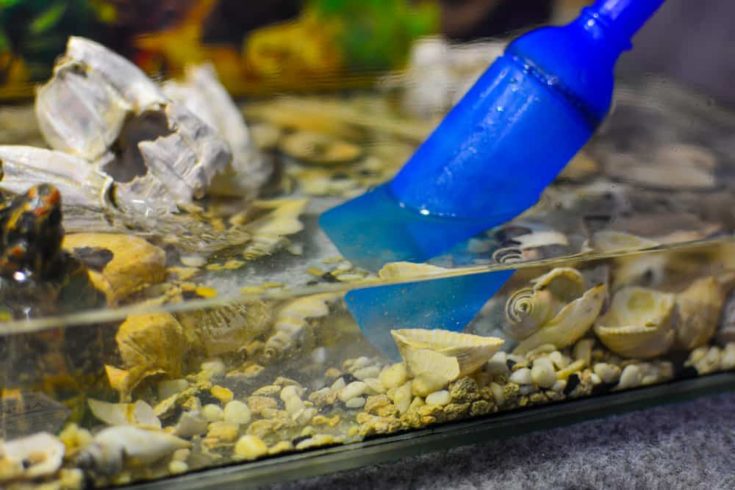
Get into the habit of carrying out partial water changes every week to remove excess nitrates from the water. Also, lighten the load on your filter by removing fish waste and debris from the substrate using an aquarium vacuum. Aim to change up to 30% of the tank water, and remember to add dechlorinator to tap water before adding it to the aquarium.
4. Manage Filtration Equipment
Over time, filters can become clogged with gunk and general detritus. So, every month or so, remove the filter from the tank and rinse the unit through in a bucket of tank water. You may also like to use an old, soft toothbrush to clean the impeller so that it can move freely.
5. Don’t Overfeed Your Fish
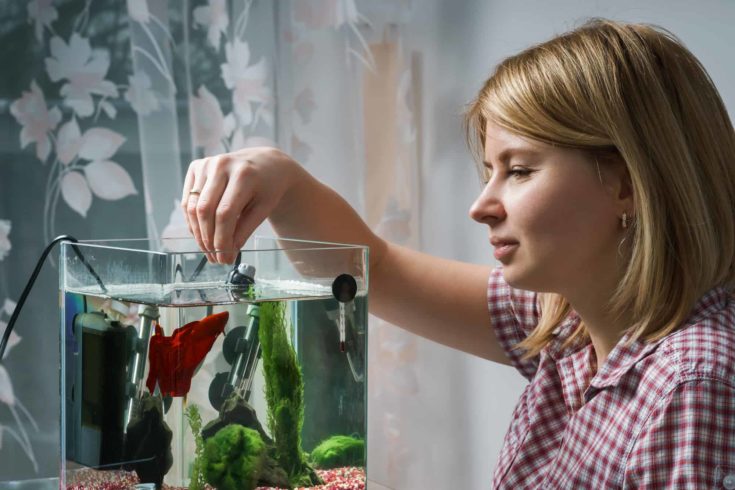
A mistake that novice aquarists often make is to overfeed their fish. Uneaten food ends up as waste on the substrate, which then decomposes and pollutes the water. Also, many fish species can suffer serious health problems if they eat too much, so feed your fishy friends little and often.
Conclusion
Did you enjoy our guide to the nitrogen cycle in the aquarium? I hope you found the information helpful and that you now understand the importance of cycling your new tank before you rush ahead and fill it with fish.
Key takeaways …
Certain species of bacteria consume harmful ammonia that is produced by fish and decomposing waste, turning the ammonia to nitrite, and ultimately to relatively harmless nitrates that are removed by plants and regular water changes. Cycling your tank involves allowing those bacteria to become established in your filtration system, purifying the water, and making the environment safe to welcome your new fish.
Tell us what you thought of this guide in the comments box below, and please share the article with other hobbyists if you enjoyed the guide and found it useful.
